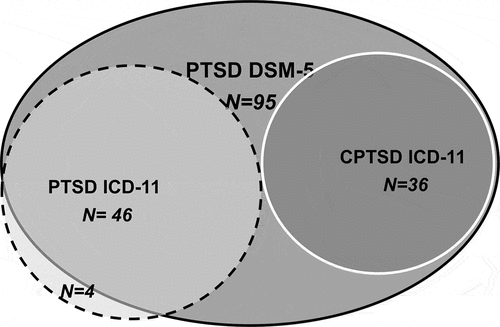Figures & data
Table 1. Comparison of list of items indicated in the ICD-11 International Trauma Questionnaire and items extracted from PCL-5.
Table 2. Trauma exposure reported by refugees.
Table 3. Frequencies and percentages of refugees meeting diagnostic criteria for each PTSD and DSO symptom cluster, PTSD and CPTSD diagnosis (N = 120).
Figure 1. Venn diagram representing the distribution of particpants diagnoses according to both DSM-5 and ICD-11 criteria.

Table 4. Frequency, sensitivity, specificity, positive predictive power and negative predictive power of PTSD symptoms in relation to DSM-5 PTSD diagnosis. Sensitivity: The probability of the presence of the symptom when PTSD diagnosis is present. Specificity: The probability of the absence of the symptom when PTSD diagnosis is absent. Positive predictive power: The probability of the presence of PTSD diagnosis when the symptom is present. Negative predictive power: The probability of the absence of PTSD diagnosis when the symptom is absent.
Table 5. Frequency, sensitivity, specificity, positive predictive power and negative predictive power of CPTSD symptoms in relation to ICD-11 CPTSD diagnosis. Sensitivity: The probability of the presence of the symptom when CPTSD diagnosis is present. Specificity: The probability of the absence of the symptom when CPTSD diagnosis is absent. Positive predictive power: The probability of the presence of CPTSD diagnosis when the symptom is present. Negative predictive power: The probability of the absence of CPTSD diagnosis when the symptom is absent.
Table 6. Fit indices for LCA (N = 120). Note: AIC, Akaike Information Criterion; BIC, Bayesian Information Criterion; sample size-adjusted BIC; BLRT, Bootstrap likelihood ratio test; Best-fitting model in bold.
Table 7. Multinomial logistic regression results predicting PTSD and CPTSD class membership (N = 120).
Table 8. Linear regression (R2 = 0.107) results predicting 20 items PCL-5 score.

